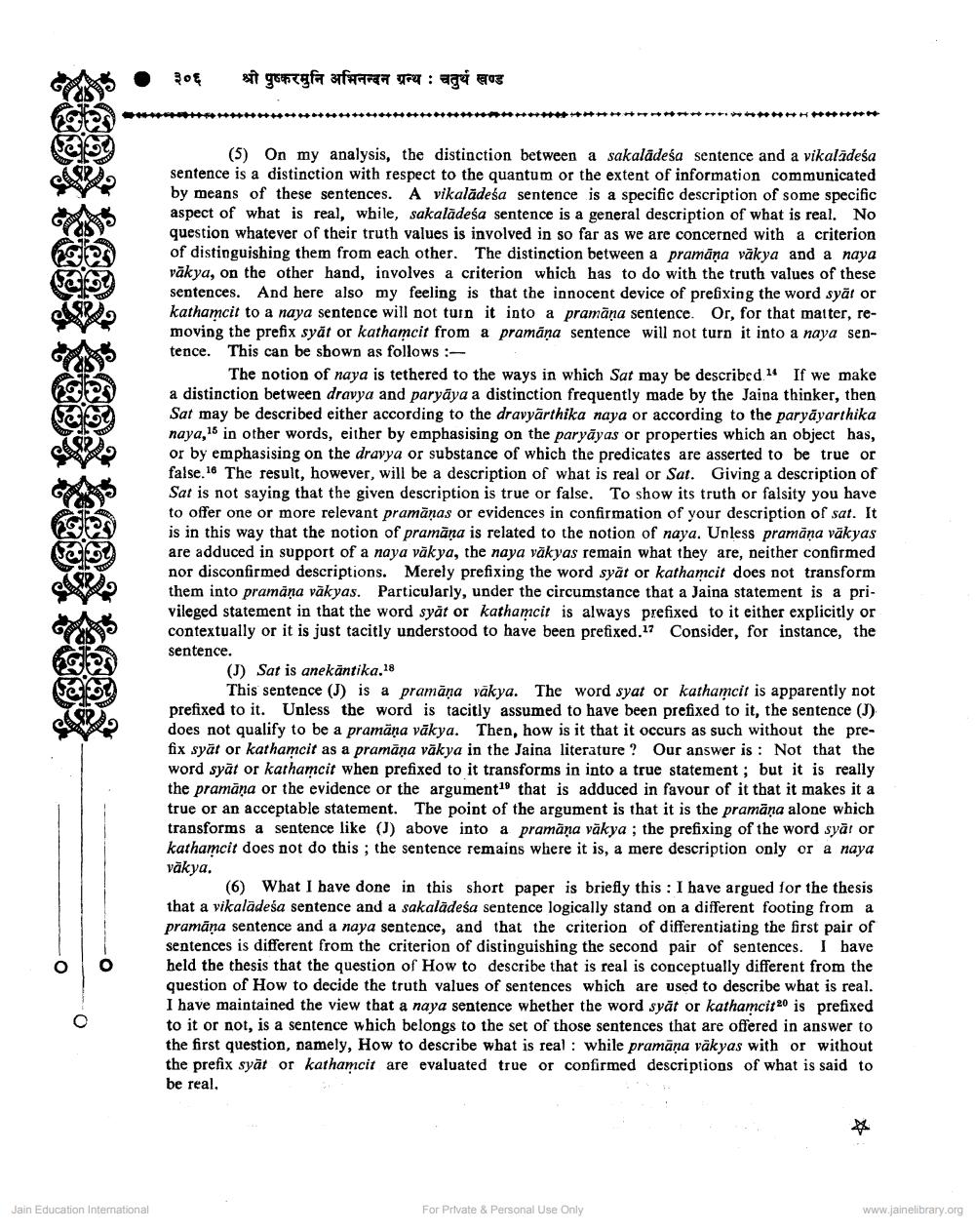________________
O
Jain Education International
३०६
श्री पुष्करमुनि अभिनन्दन ग्रन्थ : चतुर्थ खण्ड
(5) On my analysis, the distinction between a sakalādeśa sentence and a vikalādeśa sentence is a distinction with respect to the quantum or the extent of information communicated by means of these sentences. A vikalādeśa sentence is a specific description of some specific aspect of what is real, while, sakaladeśa sentence is a general description of what is real. No question whatever of their truth values is involved in so far as we are concerned with a criterion of distinguishing them from each other. The distinction between a pramāņa vākya and a naya vakya, on the other hand, involves a criterion which has to do with the truth values of these sentences. And here also my feeling is that the innocent device of prefixing the word syāt or kathamcit to a naya sentence will not turn it into a pramāņa sentence. Or, for that matter, removing the prefix syat or kathamcit from a pramāņa sentence will not turn it into a naya sentence. This can be shown as follows:
The notion of naya is tethered to the ways in which Sat may be described 14 If we make a distinction between dravya and paryaya a distinction frequently made by the Jaina thinker, then Sat may be described either according to the dravyarthika naya or according to the paryayarthika naya,15 in other words, either by emphasising on the paryayas or properties which an object has, or by emphasising on the dravya or substance of which the predicates are asserted to be true or false.16 The result, however, will be a description of what is real or Sat. Giving a description of Sat is not saying that the given description is true or false. To show its truth or falsity you have to offer one or more relevant pramānas or evidences in confirmation of your description of sat. It is in this way that the notion of pramāṇa is related to the notion of naya. Unless pramāņa vākyas are adduced in support of a naya vakya, the naya vakyas remain what they are, neither confirmed nor disconfirmed descriptions. Merely prefixing the word syat or kathamcit does not transform them into pramāņa vākyas. Particularly, under the circumstance that a Jaina statement is a privileged statement in that the word syat or kathamcit is always prefixed to it either explicitly or contextually or it is just tacitly understood to have been prefixed.17 Consider, for instance, the sentence.
(J) Sat is anekantika.18
This sentence (J) is a pramāņa vākya. The word syat or kathamcit is apparently not prefixed to it. Unless the word is tacitly assumed to have been prefixed to it, the sentence (J) does not qualify to be a pramāņa vākya. Then, how is it that it occurs as such without the prefix syat or kathamcit as a pramāņa vākya in the Jaina literature? Our answer is: Not that the word syat or kathamcit when prefixed to it transforms in into a true statement; but it is really the pramāna or the evidence or the argument19 that is adduced in favour of it that it makes it a true or an acceptable statement. The point of the argument is that it is the pramāna alone which transforms a sentence like (J) above into a pramaņa vākya; the prefixing of the word syar or kathamcit does not do this; the sentence remains where it is, a mere description only or a naya vākya.
(6) What I have done in this short paper is briefly this: I have argued for the thesis that a vikalādesa sentence and a sakalādeśa sentence logically stand on a different footing from a pramāņa sentence and a naya sentence, and that the criterion of differentiating the first pair of sentences is different from the criterion of distinguishing the second pair of sentences. I have held the thesis that the question of How to describe that is real is conceptually different from the question of How to decide the truth values of sentences which are used to describe what is real. I have maintained the view that a naya sentence whether the word syat or kathamcit 20 is prefixed to it or not, is a sentence which belongs to the set of those sentences that are offered in answer to the first question, namely, How to describe what is real: while pramāņa vākyas with or without the prefix syat or kathamcit are evaluated true or confirmed descriptions of what is said to be real.
For Private & Personal Use Only
*
www.jainelibrary.org




